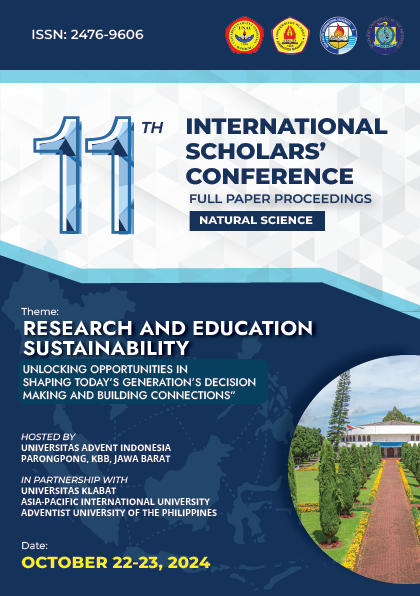Investigating the Therapeutic Promise of Mimosa pudica for Diabetes: A Computational Perspective
Keywords:
Mimosa Pudica, Antidiabetic, Molecular Docking, PhytochemicalAbstract
The rising global incidence of diabetes mellitus underscores the urgent demand for innovative antidiabetic agents. This study investigates the therapeutic potential of Mimosa pudica L. (commonly known as the sensitive plant), recognized for its traditional medicinal uses, as a possible antidiabetic agent through an in-silico approach. Utilizing bioinformatics tools and databases, we conducted a comprehensive analysis of the phytochemical constituents of Mimosa pudica, concentrating on their molecular interactions and potential inhibitory effects on key diabetes-related enzymes, specifically 11β-Hydroxysteroid Dehydrogenase Type 1 (11β-HSD1), Glutamine-Fructose-6-Phosphate Transaminase (GFAT), SIRT6, and Protein-Tyrosine Phosphatase 1B (PTP1B). Our findings reveal that certain bioactive compounds within Mimosa pudica exhibit strong binding affinity to these targets, suggesting potential inhibitory actions. This computational study provides compelling preliminary evidence for the antidiabetic efficacy of Mimosa pudica, positioning it as a candidate for further in-vitro and in-vivo investigations. The research highlights the significance of integrating computational methods in exploring plant-based therapeutics, which could revolutionize diabetes management strategies.
Downloads
References
Adurosakin, O. E., Iweala, E. J., Otike, J. O., Dike, E. D., Uche, M. E., Owanta, J. I., Ugbogu, O. C., Chinedu, S. N., & Ugbogu, E. A. (2023). Ethnomedicinal uses, phytochemistry, pharmacological activities and toxicological effects of Mimosa pudica- A review. Pharmacological Research - Modern Chinese Medicine, 7, 100241. https://doi.org/10.1016/j.prmcm.2023.100241
Banday, M. Z., Sameer, A. S., & Nissar, S. (2020). Pathophysiology of diabetes: An overview. Avicenna Journal of Medicine, 10(4), 174–188. https://doi.org/10.4103/ajm.ajm_53_20
Chaachouay, N., & Zidane, L. (2024). Plant-Derived Natural Products: A Source for Drug Discovery and Development. Drugs and Drug Candidates, 3(1), 184–207. https://doi.org/10.3390/ddc3010011
Deshpande, T. A., Isshak, M., & Priefer, R. (2020). PTP1B Inhibitors as Potential Target for Type II Diabetes. Agricultural Research & Technology: Open Access Journal, 14(1), 1–13. https://doi.org/10.19080/CRDOJ.2020.14.555876
Kupczyk, D., Bilski, R., Kozakiewicz, M., Studzińska, R., Kędziora-Kornatowska, K., Kosmalski, T., Pedrycz-Wieczorska, A., & Głowacka, M. (2022). 11β-HSD as a New Target in Pharmacotherapy of Metabolic Diseases. International Journal of Molecular Sciences, 23(16), 8984. https://doi.org/10.3390/ijms23168984
Li, D., Zhang, S., Yang, C., Li, Q., Wang, S., Xu, X., Hao, J., & Li, C. (2021). A Novel PTP1B Inhibitor-Phosphate of Polymannuronic Acid Ameliorates Insulin Resistance by Regulating IRS-1/Akt Signaling. International Journal of Molecular Sciences, 22(23), 12693. https://doi.org/10.3390/ijms222312693
Mohanty, M., & Mohanty, P. S. (2023). Molecular docking in organic, inorganic, and hybrid systems: A tutorial review. Monatshefte Für Chemie - Chemical Monthly, 154(7), 683–707. https://doi.org/10.1007/s00706-023-03076-1
Oliveira, I. A., Allonso, D., Fernandes, T. V. A., Lucena, D. M. S., Ventura, G. T., Dias, W. B., Mohana-Borges, R. S., Pascutti, P. G., & Todeschini, A. R. (2021). Enzymatic and structural properties of human glutamine:fructose-6-phosphate amidotransferase 2 (hGFAT2). The Journal of Biological Chemistry, 296. https://doi.org/10.1074/jbc.RA120.015189
Pinzi, L., & Rastelli, G. (2019). Molecular Docking: Shifting Paradigms in Drug Discovery. International Journal of Molecular Sciences, 20(18), 4331. https://doi.org/10.3390/ijms20184331
Rizwan, K., Majeed, I., Bilal, M., Rasheed, T., Shakeel, A., & Iqbal, S. (2022). Phytochemistry and Diverse Pharmacology of Genus Mimosa: A Review. Biomolecules, 12(1), 83. https://doi.org/10.3390/biom12010083
Ruegenberg, S., Horn, M., Pichlo, C., Allmeroth, K., Baumann, U., & Denzel, M. S. (2020). Loss of GFAT-1 feedback regulation activates the hexosamine pathway that modulates protein homeostasis. Nature Communications, 11(1), 687. https://doi.org/10.1038/s41467-020-14524-5
Smirnov, D., Eremenko, E., Stein, D., Kaluski, S., Jasinska, W., Cosentino, C., Martinez-Pastor, B., Brotman, Y., Mostoslavsky, R., Khrameeva, E., & Toiber, D. (2023). SIRT6 is a key regulator of mitochondrial function in the brain. Cell Death & Disease, 14(1), 1–12. https://doi.org/10.1038/s41419-022-05542-w
Trott, O., & Olson, A. J. (2010). AutoDock Vina: Improving the speed and accuracy of docking with a new scoring function, efficient optimization, and multithreading. Journal of Computational Chemistry, 31(2), 455–461. https://doi.org/10.1002/jcc.21334
Zheng, Y., Ley, S. H., & Hu, F. B. (2018). Global aetiology and epidemiology of type 2 diabetes mellitus and its complications. Nature Reviews. Endocrinology, 14(2), 88–98. https://doi.org/10.1038/nrendo.2017.151
Downloads
Published
How to Cite
Issue
Section
License
Copyright (c) 2024 11th International Scholars Conference

This work is licensed under a Creative Commons Attribution-ShareAlike 4.0 International License.
Copyright © 2024 ISC Committee.















